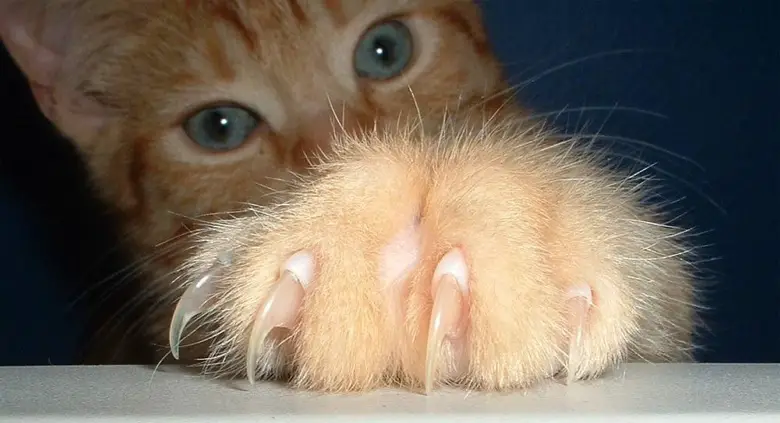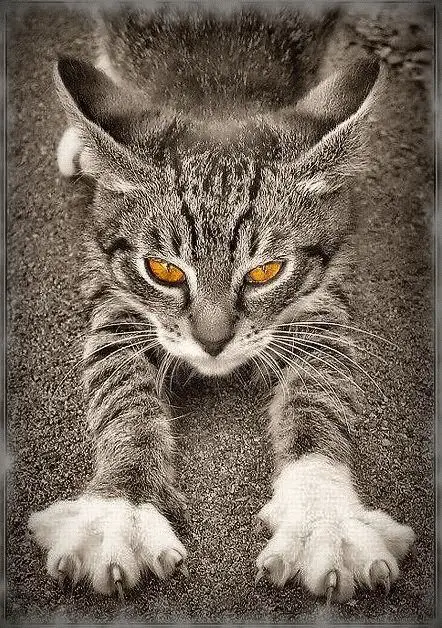BY LAUREN MIELI, EDITOR, THE CATNIP TIMES
To declaw or not to declaw…have you struggled with that question? I personally do not believe in declawing cats, under any circumstance…but I do believe in providing the best information so that people
can make informed decisions. The decision to declaw is one that should not be taken lightly – if you are considering this, be sure to do your homework – you owe it to your cat.
The American Veterinary Medical Association (AVMA) recently announced an amendment to their declaw policy:
“… the procedure is a major surgery that should only be performed after alternatives have been sought to prevent destructive clawing.”
The AVMA stresses that declawing should be done as an absolute last resort – only when euthanasia is being considered or possibly when the cat’s claws could harm a person, such as an elderly adult with very thin skin (if the cat is a companion animal to that person).
I applaud this, as a step in the right direction, and at the same time recognize that in the U.S., we have a long way to go in educating the public about declawing. At least 22 countries outlaw declawing including Australia, Brazil, Israel, Europe, Austria and UK. The surgery is only to be performed if it will be of benefit to the animal (for medical reasons). Many veterinarians are refusing to do the surgery… though all too many are still out to make a buck, and are not looking out for the welfare of the animal.
As Marcus Brown, President of the American Association of Feline Practitioners said,
“I went into veterinary medicine to do no harm.”
Most cat owners, and especially new cat owners, may not realize that declawing, also known as onychectomy, is actually amputation. It is the removal of the last bone – it’s like cutting off a finger at the knuckle. Therefore, this surgery is both elective and irreversible. Some people will try to tell you that newer laser surgeries for declawing are not cruel. The fact remains, the animal is harmed in the surgery, they still experience pain, and a cat’s claws are a natural part of their body that they want to use and should be allowed to use. If you haven’t seen a cat race up a cat tree – you’re missing out… it’s one of the wonders of a cat!
Types of Declaw Procedures (Purely informational, but I do not condone)
- Surgical incisions and/or the use of clippers to remove the last bone and claw. The wounds are stitched up using traditional sutures. (Ouch!!) It can takes several days to several weeks for the wounds to heal. Many cats experience ongoing tenderness, sensitivity and pain, long after the wounds have healed.
- Laser removal of the claws which vaporizes the claw/bone area. Seen as less invasive, more expensive and many veterinarians do not have the proper equipment. Recovery time may be shorter, but it is still damaging to the animal.
- Tendonectomy – The removal/cutting of the tendons that connect the claw to the last bone. The claw is left intact, but it does not work. Still painful for the cat. Nails will still need to be trimmed.
While cats eventually recover, the pain to have all “fingers” amputated must be unimaginable and horrendous. Cats under a year old typically recover faster that older or obese cats who put more weight on their paws.
Unintended consequences can happen as a result of declawing. For example, many cats who are declawed have been known to develop an aversion to the litter box. The theory is that their paws remain very sensitive to scratching litter, and they associate pain with the litter box and choose to do their business elsewhere… leading to other behavior problems. Additionally, some studies have shown that without claws, a cat may resort to biting to defend itself.
The Bottom Line
Your cat’s claws are a natural part of who they are. If you are a cat owner, or thinking of owning a cat, please consider keeping your cat’s claws intact – they use them just like we use fingers. Solutions exist to live in harmony with your cat’s claws:
- Trim the nail regularly – From the time your cat is a kitten, be sure to trim its nails. It takes minutes and will prevent any damage to people or furniture when nails are short.
- Provide plenty of scratching areas – Cats love to scratch. It’s in their nature. They love to scratch both horizontal and vertical surfaces and they prefer different types of surfaces: sisal, carpet, wood. Provide variety for your cat and you’ll both be happy. Try the SmartCat Scratching Post! I highly recommend it.
- Use double-sided tape – Use double-sided tape specifically made for furniture to deter your kitty from scratching. When your kitty goes to scratch the
corner of your couch, they will be trained to avoid the area when they’re met with the tacky substance. Other cat deterrants are available, but sticky tape is my favorite.
- Try soft paws claw covers – If all else fails, you can always have your vet put soft paws on your cat’s claws. Soft paws are soft plastic covers made to cover a cat’s claw and prevent them from scratching.
- Never scold your cat for scratching. Remember that scratching is 100% natural cat behavior. Instead, gently redirect the cat to an appropriate scratching surface, like a scratching post rubbed with catnip and then praise your cat. Positive reinforcement goes a long way in training and retraining your cat.
- Provide an enriching environment for your cat. Be sure to provide multiple scratching posts, cat trees and other areas where your cat can act like a cat. When you’re able to redirect your cat’s energy appropriately onto these areas, you’ll see that they prefer them over your sofa. I have cat scratching posts in the bedroom, the hallway, and the family room. In short, I provide an appropriate scratching surface in the areas of my home where I spend the most time (and my cats spend the most time).
Looking Forward
I grew up with cats in the 70’s and 80’s and all of our cats were declawed. I was a kid and we didn’t know any better. As an adult, I educated myself first and then committed to providing an enriching environment for my cats that includes lots of areas to scratch and climb. I do not have any issues with inappropriate scratching and my cats are happy.
My hope is that there will be a day when people, especially those in the U.S., will learn to appreciate cats for their natural beauty and instincts and stop putting their own desires and conveniences (read furniture) ahead of their pet’s health, safety and comfort.
Read the AVMA’s full statement.
What are your thoughts on declawing? When commenting, let us know what country you’re from. I think it would be interesting to get all different perspectives! Please be respectful.



